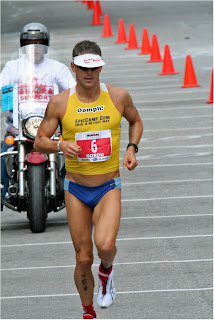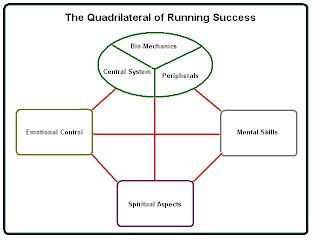
June 13, 2009
At the British World Trials in Birmingham Meseret Defar (ETH) became only the fifth woman
to run faster than 30 minutes for 10000 m with a career best 29:59.20.
Aviva World Trials and UK Championships
Birmingham, GBR, 10-12 July
WOMEN
10000 (11):
1. Meseret Defar, ETH 29:59.20 PB
2. Aheza Kiros, ETH 31:21.22
3. Lineth Chepkurui, KEN 31:31.92 PB
4. Christine Bardelle, FRA 32:44.48
5. Claire Hallissey 33:10.73 PB
Only four athletes remain in contention for the Golden League jackpot: Kenenisa Bekele,
Kerron Stewart, Yelena Isinbayeva and Sanya Richards. The next meeting is this Friday in
Paris.
5000:
1. Kenenisa Bekele, ETH 12:56.23 SB
2. Mark Kiptoo, KEN 12:57.62 PB
3. Leonard Patrick Komon, KEN 12:58.24 PB
4. Lucas Kimeli, KEN 12:58.70 PB
5. Bekana Daba, ETH 12:59.22 PB
IAAF World Youth Championships (6th)
Bressanone, ITA, 8-12 July
BOYS
800 (11):
1. Johan Rogestedt, SWE, 1993 1:50.92 PB Gold
2. Peter Kiplangat, KEN, 1993 1:50.97 Silver
3. Nicholas Kipkoech, KEN, 1992 1:51.01 Bronze
This is a swift 1500m for boys!
1500 (12):
1. Gideon Mageka, KEN, 1993 3:37.36 PB Gold
2. Caleb Ndiku, KEN, 1992 3:38.42 Silver
3. Girma Bekele, ETH, 1992 3:39.88 PB Bronze
3000 (12):
1. Isaiah Koech, KEN, 1992 7:51.51 PB Gold
2. David Bett, KEN, 1992 7:52.13 PB Silver
3. Goitom Kifle, ERI, 1993 8:05.83 PB Bronze
2000 s/chase(12):
1. Hillary Yego, KEN, 1992 5:25.33 PB Gold
2. Peter Lagat, KEN, 1992 5:26.59 PB Silver
3. Desta Alemu, ETH, 1992 5:29.66 PB Bronze
GIRLS
800 (12):
1. Cherono Koech, KEN, 1992 2:01.67 PB Gold
2. Ciara Mageean IRL, 1992 2:03.07 NJR, NYR Silver
3. Rowena Cole, GBR, 1992 2:03.83 PB Bronze
1500 (11):
1. Nelly Ngeiywo, KEN, 1992 4:12.76 PB Gold
2. Gete Dima, ETH, 1992 4:15.16 Silver
3. Amela Terzic, SRB, 1993 4:16.71 PB Bronze
3000 (08):
1. Purity Rionoripo, KEN, 1993 9:03.79 Gold
2. Jackline Chepngeno, KEN, 1993 9:05.93 PB Silver
3. Genet Yalew, ETH, 1992 9:08.95 PB Bronze
2000 s/chase (10):
1. Korahubish Itaa, ETH, 1992 6:11.83 WYB Gold
2. Lucia Muangi, KEN, 1992 6:11.90 NR, NJR, NYR Silver
3. Halima Hassen, ETH, 1992 6:16.83 PB Bronze
I see that Bernard Lagat ran a 3:32.56 in Tangier on 1 July, so he’s coming into the kind of shape that had him win both the 1500m & the 5000m at World Champs – another good sign for US middle distance running this year.
The Moroccans are great distance runners from 800m to 5000m & beyond; seems they now have a steeplechaser whose figuring it out: Jamel Chatbi ran an 8:08.86 PR in a new Moroccan record at the same meet in Tangier.
However the 1500m for men is on fire this year! Check out these results:
Golden Gala (29th)
(IAAF Golden League)
Rome, ITA, 10 July
1. Asbel Kiprop, KEN 3:31.20 PB
2. Amine Laalou, MAR 3:31.56 PB
3. William Biwott (Jr.), KEN 3:31.70 PB
4. Tarek Boukensa, ALG 3:32.03 SB
5. Belal Mansoor Ali, BRN 3:32.10 SB
In this same Golden Gala, we saw another US woman go under 4 minutes for 1500m; this IS good news, perhaps Jenny Barringer has opened up the flood gates at last. Sub 4 was an almost impossible time in the past. Good for Christin Wurth-Thomas!
1. Maryam Yusuf Jamal, BRN 3:56.55 SB
2. Christin Wurth-Thomas, USA 3:59.98 PB
3. Oksana Zbrozhek, RUS 4:01.48 PB
4. Sonja Roman, SLO 4:02.13 NR
5. Viola Kibiwot, KEN 4:03.22
6. Mariem Alaoui Selsouli, MAR 4:03.76 SB
7. Kalkidan Gezahegne, ETH 4:04.04 PB
8. Lidia Chojecka, POL 4:04.83 SB
9. Irene Jelagat, KEN 4:05.11 SB
10. Anna Mishchenko, UKR 4:06.56 SB
Pretty deep race, 4:06 for 10th
Till next time – run loose, run light, run free
Bobby McGee




















